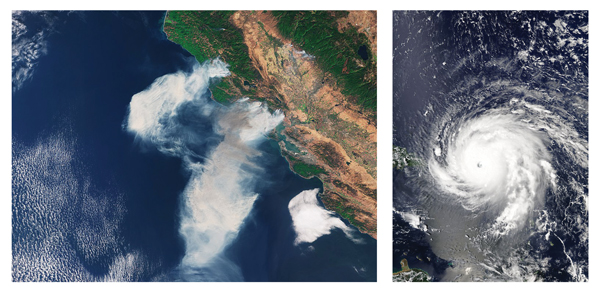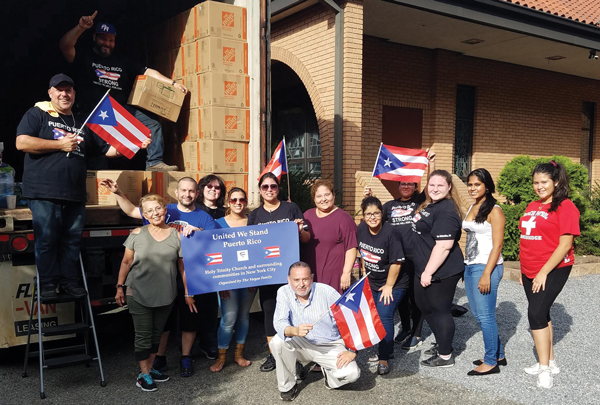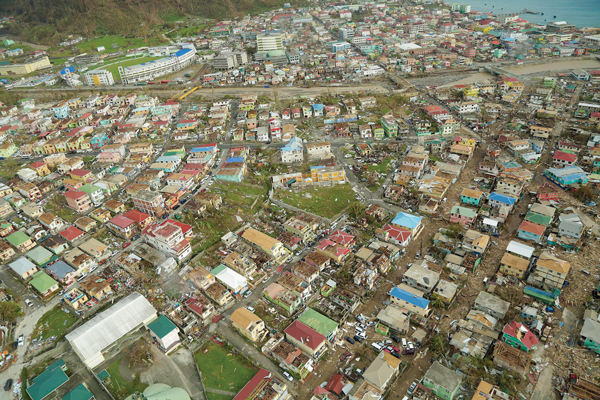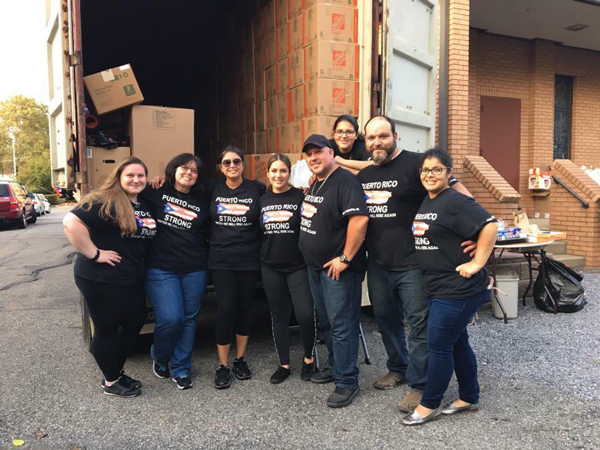BY MADELEINE MACCAR
 L to R: Satellite view of the California wildfires and Hurricane Irma at peak intensity
Last month, as we were putting the finishing touches on an article about weather-related incidents impacting the industry, we were surprised again by Mother Nature in the form of back-to-back-to-back powerful storms, fires, and earthquakes. We knew immediately that a second article would be required. When Hurricane Harvey tore through the Caribbean, Latin America, and the southern U.S. at the end of August and early September, it was just the beginning: A tragic trifecta augmented by nature’s fury would hammer the United States from coast to coast to relentlessly savage far-reaching swaths of people—including the tight-knit extended family comprising the chauffeured transportation industry.
L to R: Satellite view of the California wildfires and Hurricane Irma at peak intensity
Last month, as we were putting the finishing touches on an article about weather-related incidents impacting the industry, we were surprised again by Mother Nature in the form of back-to-back-to-back powerful storms, fires, and earthquakes. We knew immediately that a second article would be required. When Hurricane Harvey tore through the Caribbean, Latin America, and the southern U.S. at the end of August and early September, it was just the beginning: A tragic trifecta augmented by nature’s fury would hammer the United States from coast to coast to relentlessly savage far-reaching swaths of people—including the tight-knit extended family comprising the chauffeured transportation industry.
While the “acts of god” were the main events, the true stories that arose from the tragedies were the triumph of the human spirit to not only reemerge after such a catastrophic incident, as well as those who came to assist. It’s that closeness that facilitates hope when all seems lost, though. And that hope and its subsequent outpouring of selfless generosity and big-hearted efforts serve as a beacon of light in the darkest times, as the luxury ground transportation industry proved that it is truly a far-flung family that always takes care of its own.
October’s California Wildfire
An increase of much-needed rainfall earlier in the year was no match for the fires that ravaged California in 2017, especially in the prodigiously harrowing month of October. Northern California, known for its world-renowned wineries and breathtaking panoramas, became nothing short of a fiery inferno after the blazes that ignited between October 8 and 9 spread with horrifying speed. Soon, 21 individual wildfires were burning across a staggering 245,000 acres, consuming Napa, Lake, Sonoma, Mendocino, Butte, and Solano counties.
By Halloween, the series of fires had claimed 43 lives and left 185 injured. And while Greater California Livery Association Executive Director Tom Garrett reports that much of the industry’s companies in the affected areas emerged from the raging fires relatively unscathed once they were allowed back home, they are struggling to return to business as usual.
How Can You Help?
The road to recovery is going to be a long one—Puerto Rico alone is expected to be struggling for months if not a full year—and so there are still plenty of ways to help those who have been left most vulnerable.
napavalleycf.org/supporting-napa-county-fire-relief-efforts/
The Napa Valley Community Foundation (NVCF) has mobilized its Disaster Relief Fund to come to the aid of those who faced significant losses in the wine-country wildfires. Here, you can find fundraisers, as well as updates on how donor money is being spent on the affected community.
gofundme.com/gbta-hurricane-harvey-recovery-fund
What began as a Harvey relief fund quickly spiraled into a catch-all hurricane-recovery program for Global Business Travel Association members affected by the trio of 2017 Atlantic hurricanes, especially those in Florida.
gofundme.com/help-for-san-sebastian-pr
The Vargases’ fundraiser for Mike’s hometown of San Sebastian might have completed its first delivery of desperately needed resources, food, and hands-on assistance, but the couple fully expect to keep donations funneling to Puerto Rico for as long as they’re needed.
“The fires have really affected the demand for their business so I know on a revenue basis, a lot of the Napa operators are hurting,” he says. Keep in mind that October’s fires were preceded by blazes that started back in August and September, half a dozen of which were still not even fully contained by the beginning of November—like Siskiyou County in Northern California, where the fires are barely halfway under control.
Christina Mae Zanone, affiliate manager for Beau Wine Tours in the heart of Napa, soon found herself fielding calls from opportunists who expect discounted services in the aftermath of the fires. Fortunately, such gauche behavior has been the exception rather than the norm as she and scores of others ventured back from their evacuation havens in search of whatever silver lining they could find.
“Harvest season was nearing its end, with 90 percent of grapes already picked,” she confirms, adding that she has also put a call out for other affiliate managers to advocate for the reinvigoration of the hearty region’s autumn and winter business. “Vines are hard to burn and they are resilient, just like our community is. Containment grows, smoke is there, but it is blowing off. It’s getting better, and I, for one, am so blessed to be a part of this amazing community that comes together and stands to face it all. But from a business standpoint, we need help getting the word out that our valley has not crumbled, that it’s open and ready to move forward. We need the work to help us rebuild.”
And if the flurry of activity following her widely shared Facebook plea for tourist support was any indication, the nationwide industry is primed and ready to ensure that its family in post-fire wine country will not falter under its watch.
 Dh2 Chauffeured Transportation’s Mike and Nancy Vargas—plus the Holy Trinity Church community—filled a 40-foot container in early October for Mike’s hometown of San Sebastian in Puerto Rico
Hurricanes Irma and Maria
Dh2 Chauffeured Transportation’s Mike and Nancy Vargas—plus the Holy Trinity Church community—filled a 40-foot container in early October for Mike’s hometown of San Sebastian in Puerto Rico
Hurricanes Irma and Maria
Instead of being an isolated incident, Harvey’s devastation was a prelude to a “hyperactive” Atlantic hurricane season almost unfathomable in its destruction—and in an improbably limited timeframe, too.
Befitting the fifth-most active season since recordkeeping commenced in 1851, the six-month storm cycle saw 17 total storms and a staggering six hurricanes that raged at a Category 3 or above. But September alone saw the tail end of Hurricane Harvey as well as suffered the record-breaking wrath of Irma (Category 5), Jose (Category 4), and Maria (Category 5). In many cases, if Maria didn’t exacerbate what Irma started, the ruthless storm bore down on those who had just heaved a sigh of relief barely two weeks earlier.
Aside from the temporarily unreachable Florida Keys, the continental United States was, in hindsight, comparatively spared during the storms themselves; the 82 deaths from Irma (with a total body count of 134) were largely consequences of not heeding mandatory evacuations or the tragic failure of an overtaxed infrastructure not being able to handle unimaginable storm-stress, like the nursing home where 14 elderly patients died from their nursing home’s sweltering conditions due to a lack of power in the facility. Maria’s four U.S. deaths were all drownings related to its far-reaching rip currents.
“Think of them during your year-end charitable giving: Those living in ravaged areas still need assistance for weeks and months to come.”
THE INDUSTRY REACTS
During a recent ride with Cliff Wright of GoOrlando Limos/Royal Transportation Group, the Long Island transplant compares the one-two punch of twin hurricanes with other natural disasters he’s seen in almost two decades of life in The Sunshine State. It’s late October, a full month since Florida has experienced the final effects of Maria, and he points out blue-tarp roofs, still-downed trees, and newly vacant holes interrupting the landscape of a mere 30-minute drive.
 Above: an aerial view of Dominica’s capital city Roseau post-Maria
“You know the food lines?” he asks, referring to the D-snap program that works as a sort of short-term assistance for victims of disasters who don’t ordinarily qualify for food stamps. “You still see people standing in line. People still need help. They still haven’t recovered.”
Above: an aerial view of Dominica’s capital city Roseau post-Maria
“You know the food lines?” he asks, referring to the D-snap program that works as a sort of short-term assistance for victims of disasters who don’t ordinarily qualify for food stamps. “You still see people standing in line. People still need help. They still haven’t recovered.”
Fortunately, the contiguous regions of the country remained largely accessible by road during all but the worst of the hurricanes’ lashings—and, unsurprisingly, the ground transportation industry soon sprung into action. Mike and Marlo Denning of Elegant Limousines in Florida’s Daytona Beach and Palm Coast put their fleet to proactive use and helped the limitedly abled within their reach evacuate their particularly vulnerable towns, while vendors like Battisti Customs filled vehicles they had on site with highly demanded items after the storms receded and sent those packed Mercedes-Benz Sprinters to anywhere their stuffed-full assistance was needed.
With storm effects felt as far north as the Jersey Shore, it takes a particular kind of disaster to effortlessly eclipse how dire things were in the southern U.S. during and after both Irma and Maria. But when Dominica in the Caribbean declared Maria its worst natural disaster on record and the entire island of Puerto Rico was completely without power thanks to a pulverized power grid, the effects on island territories cannot be understated.
“Our office is still closed, and we do not have water or power in my state,” says Luis Jamie Patoja of Bespoke Transportation, which is routinely recognized as one of Puerto Rico’s most-awarded transportation outfits.
The devastation was so widespread that traditional emergency responses could not keep pace with the demand for even the most basic necessities.
 The Vargases’ church family displays its Puerto Rico Strong shirts
That’s when Mike and Nancy Vargas of New York’s Dh2 Chauffeured Transportation turned a conversation that started in their living room into a far-flung relief effort that saw their community and their industry come together in a swell of support for the people of San Sebastian—Mike’s home, and where much of his family still resides. The small inland town does not receive donations as quickly as more coastal Puerto Rican cities closer to the port, and the Vargases were having a hard enough time going through the motions knowing that even their accounted-for loved ones were quickly running out of potable water.
The Vargases’ church family displays its Puerto Rico Strong shirts
That’s when Mike and Nancy Vargas of New York’s Dh2 Chauffeured Transportation turned a conversation that started in their living room into a far-flung relief effort that saw their community and their industry come together in a swell of support for the people of San Sebastian—Mike’s home, and where much of his family still resides. The small inland town does not receive donations as quickly as more coastal Puerto Rican cities closer to the port, and the Vargases were having a hard enough time going through the motions knowing that even their accounted-for loved ones were quickly running out of potable water.
“We couldn’t sleep at night knowing that our family was fighting to survive,” Nancy says. “We were in New York but our hearts were in Puerto Rico. We couldn’t go on with the day-to-day of our lives without using all the resources at our disposal to help them regain theirs.”
In the end, Mike delivered a shipping crate filled with everything from bedding to food to palates and palates of drinking water to his hometown at the end of October. But he and Nancy simply see themselves as conduits of generosity, and are quick to observe that they would not have been able to provide as much if not for the people around them who rallied around their idea and turned it into a humanitarian effort.
“If not for the generosity of our extended family, we would have never been able to help San Sebastian the way we did,” Nancy says. “We saw our New York family and our industry family come together to help our Puerto Rico family. We want them to know how blessed we are to have their support when we and people they’ll never even meet need it most.” [CD1117]

